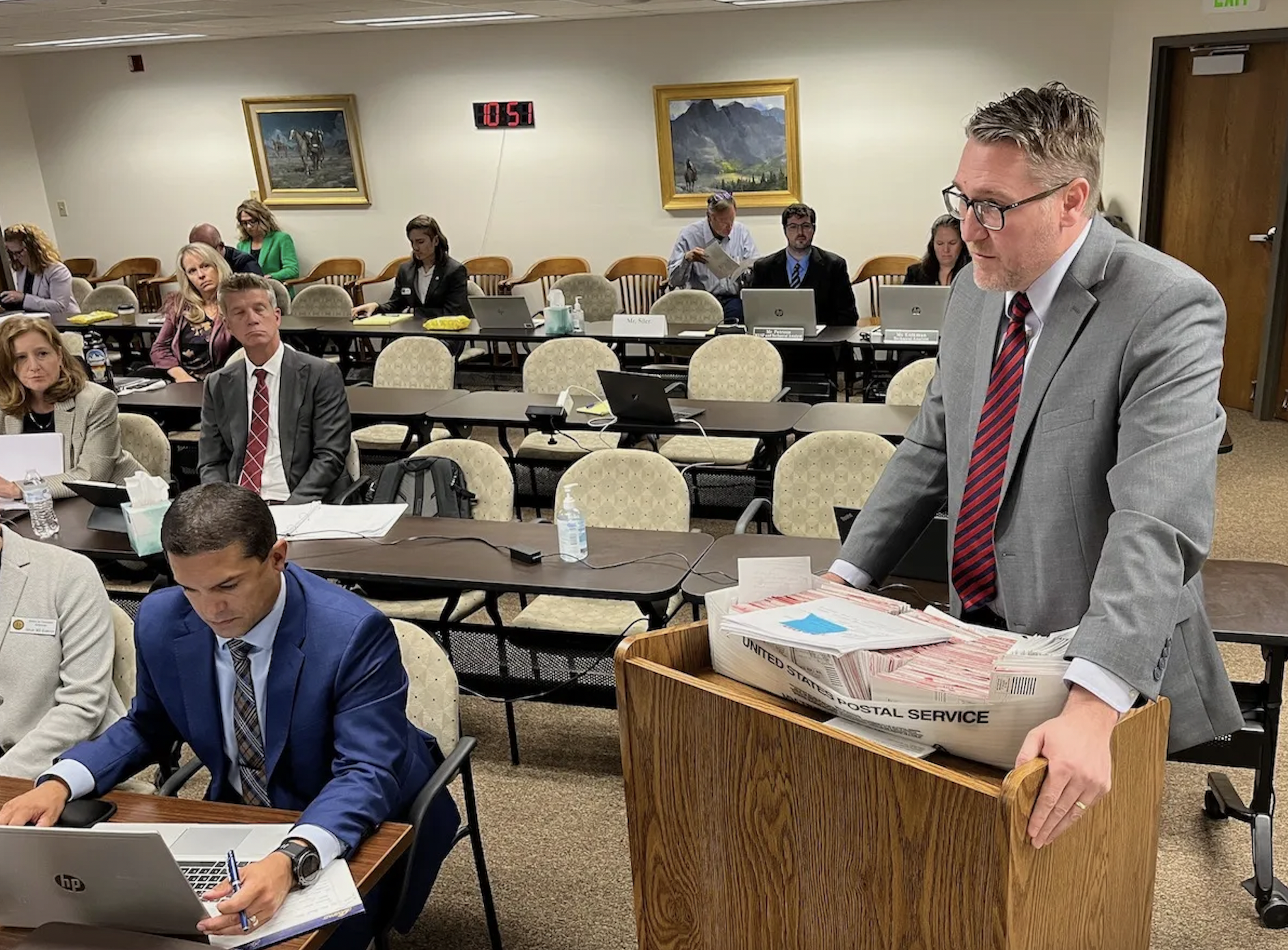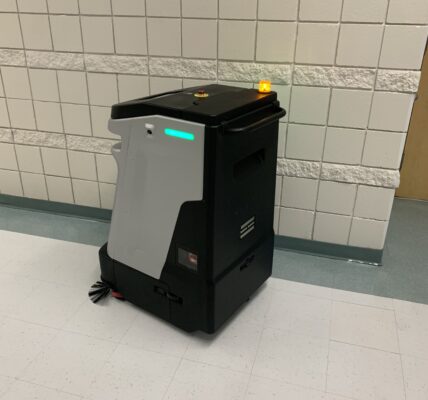
• Rocky Mountain Power faces criticism for poor public outreach and putting profit over the well-being of Wyoming’s low-income residents.
By Dustin Bleizeffer, WyoFile.com
CHEYENNE—Rocky Mountain Power officials took the stand here Wednesday to defend the company’s proposed $140.2 million rate hike — a 21.6% increase that’s sparked fear and outrage among its 144,000 customers in Wyoming.
The hike would come on top of a 7.6%, $50.2 million “fuel cost adjustment,” resulting in a cumulative 29.2% rate increase beginning in January. That would inflate the average monthly household electric bill by approximately $19.94, according to the company.
For the first time since the company filed its request in April, the Wyoming Public Service Commission and five intervening parties in the case have begun formally scrutinizing the utility’s justifications for the historic rate hike. In contrast to multiple, lively public comment hearings conducted by the commission in recent months — which included standing-room only attendance on occasion — the hearing room mostly consisted of representatives of parties involved in the formal hearing. The mood was all business.
After more than two hours of opening statements Wednesday, the hearing shifted to formal testimony with Rocky Mountain Power President and CEO Gary Hoogeveen the first to face cross-examination.
• Public outreach and outrage
The financial implications of a 29.2% electric rate increase for households, businesses and core members of Wyoming’s oil, gas and trona industries are not lost on Rocky Mountain Power — the largest regulated utility in the state and a division of billionaire Warren Buffet’s PacifiCorp, Hoogeveen said in his opening statement.
“The company understands and empathizes with its customers impacted by increasing rates, and we take that customer impact very seriously,” said Hoogeveen, a lean, towering figure who was fighting a cough.
Multiple factors outside the utility’s control — world events and weather influences on coal and natural gas markets, inflation and ever-changing environmental policies — have driven costs upward, said Hoogeveen. However, the company’s renewable energy additions, along with federal tax credits attached to the investments, helped forgo an even larger rate increase request — by about $85 million.
“As a result of [Rocky Mountain Power’s] efforts, the company’s rates are lower as compared to other investor-owned utilities,” Hoogeveen said.
Still, the company’s efforts to maintain “just and reasonable” rates amid the complexities and changing nature of the electric utility landscape hasn’t made the prospect of a 29.2% rate hike palatable to its Wyoming customers or their elected representatives.
Commission Chair Mary Throne’s first questions for Hoogeveen referred to the widespread angst among thousands of Rocky Mountain Power’s customers who attended the commission’s five public comment hearings in four towns in recent months, and the unusually large number of written comments detailing the hardships many might face. It was the commission, not Rocky Mountain Power executives, Throne alluded, that faced the brunt of that anger.
Did Hoogeveen attend any of the commission’s five public comment hearings, Throne asked.
He did not, Hoogeveen answered. But many members of the company’s team did attend in person, and Hoogeveen tuned into some of the recorded audio, he said.
Had he attended a public comment hearing, what would he have told customers, Throne asked Hoogeveen.
“I would have empathized, and I do empathize,” Hoogeveen said, adding he would tell them that Rocky Mountain Power is facing many of the same economic inflationary pressures that its customers are facing. “I think what we could have done better, if I’m being honest, is communicated to our customers” the outside factors driving the company’s rate hike request.
On Thursday, Throne continued questioning Rocky Mountain Power officials about customer outreach and the hardships they might face if the commission were to grant the company’s full request.
Upon filing the rate hike request in April, the company reached out directly to its largest Wyoming customers — which includes a coalition of oil, natural gas and trona producers and refiners — as well as city councils and other local governments, Rocky Mountain Power Vice President of Regulation Joelle R. Steward testified. The company, however, did not conduct public, informational meetings itself, she said.
Steward agreed that though Rocky Mountain Power does have voluntary energy efficiency programs and mechanisms to allow for hardship payment schedules, the company commonly refers those in need to various nonprofit and government energy assistance programs.
Throne also established with Steward that the Wyoming Low-Income Energy Assistance Program, the state’s primary resource for those in need of home energy cost assistance, currently does not receive funding from the state. Asked whether Rocky Mountain Power has advocated for state funding for Wyoming LIEAP, Steward said the company would consider it in the future.
• Just and reasonable?
The task before the commission, which regulates monopolistic utilities like Rocky Mountain Power, is to determine what costs are “just and reasonable” to pass on to Wyoming customers.
The five intervening parties in the case are Walmart Inc., Wyoming Office of Consumer Advocate, Sierra Club, Wyoming Industrial Energy Consumers and Sen. Cale Case (R-Lander). Case is participating as a citizen, but as a state lawmaker he’s also been involved with legislative efforts to curb future rate hikes.
Before the commission, the intervenors will advocate on behalf of their constituents by carefully scrutinizing not only the company’s actual expenses, but what portion of those are legally justified to pass on to Wyoming ratepayers. They’re convinced that Rocky Mountain Power is not entitled to its full request of $140.2 million.
The magnitude of Rocky Mountain Power’s proposed 29.2% electric rate hike implies that it either isn’t doing a good job of planning for cost risks or that it’s asking for too much, according to several opening statements by the intervening parties. If the company is truly so prudent at measuring markets and making penny-wise investment decisions while also prioritizing fairness and empathy with its customers, how did it come to this?
“The [Wyoming Office of Consumer Advocate] requests that the commission find the company’s requested rate increase is not just, it is not reasonable and it is not in the public’s interest,” Office of Consumer Advocate Attorney Shelby Hamilton told the commission.
Based on the office’s analysis, Rocky Mountain Power might be entitled to a rate increase of $59 million rather than its proposed $140.2 million, according to Hamilton.
The Wyoming Industrial Energy Consumers coalition, which represents several oil, natural gas and trona producers and refiners, puts that “just and reasonable” figure at $14.9 million, according to its testimony.
“The most significant adjustments we recommend to the commission include a reduction to the projected net power costs, a reduction to the level of taxes included in rates due to a disagreement as to how taxes should be accounted for in rates and a reduction to Rocky Mountain Power’s requested return on equity,” Holland and Hart attorney Abby Briggerman, who represents the coalition, told WyoFile via email.
Whatever the commission decides, any increase is going to hit especially hard for low-income households and older residents on fixed incomes, Wyoming AARP Director Sam Shumway said during public comment Wednesday.
“Folks who are dealing with hyperinflation, folks who are dealing with how they’re going to pay for rising gas prices, the cost of health care, the cost of groceries, the cost of property taxes — [they] are now being faced with a 30% increase in power,” Shumway said while displaying a box of written comment postcards from approximately 5,000 Wyoming AARP members.
If approved in its entirety, Rocky Mountain Power’s $140.2 million annual electric rate increase will also hit oil and natural gas producers in the state, Petroleum Association of Wyoming President Pete Obermueller said.
“A number of these small businesses will not be able to sustain their operations,” he told the commission. “Such an outcome would be devastating, obviously to them, but also to the communities they uplift.”
How to participate
The hearing is scheduled to continue each weekday, beginning at 8:30 a.m., through Nov. 3 at the Hanson Building in Cheyenne.
The hearing is open to the public and will be livestreamed — click here for the livestream link, or dial 1-719-359-4580, meeting ID: 819-2930-6120. The commission will provide an opportunity for public comment — both in person and via livestream — at approximately 11 a.m. each day of the hearing.
The commission will make its determination days or weeks after the formal hearing is concluded.
WyoFile is an independent nonprofit news organization focused on Wyoming people, places and policy.
1 COMMENTS
Comments are closed.






Thanks to our Wyoming government for having little fortitude against the wind and solar garbage pits that RMP is attempting to justify saddling consumers with their “pocketlining” justifications.